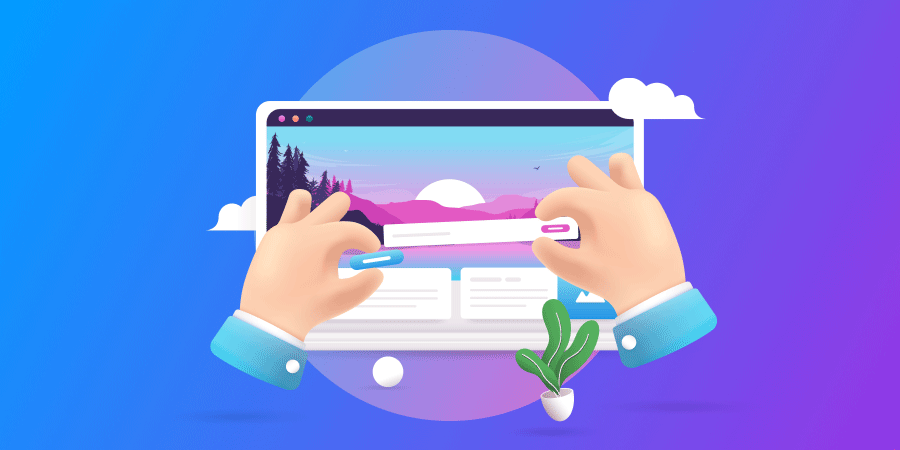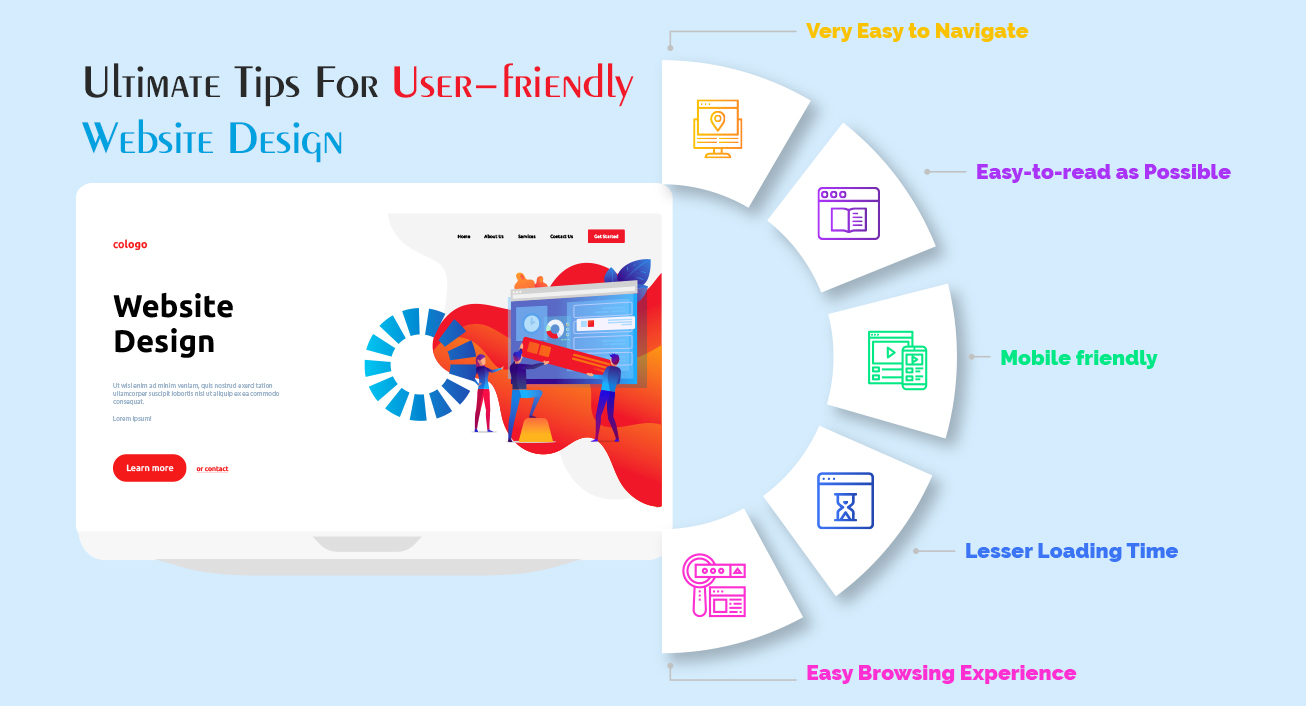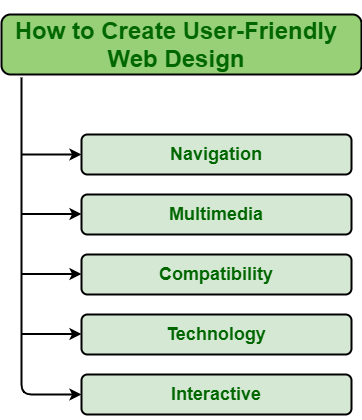Creating a user-friendly web design is essential for any business. A well-designed website attracts visitors and keeps them engaged.
It ensures easy navigation and a pleasant user experience. A user-friendly website means visitors can find what they need quickly. It should work well on all devices, from desktops to smartphones. Clear design and quick load times are key. A website that is easy to use builds trust with visitors. This leads to higher engagement and better conversion rates. If you are looking to create a user-friendly website, consider using high-quality templates. One such option is the SEOhub – Digital Marketing Agency HTML5 Template. It offers a range of features that make website creation simple and effective. Learn more about SEOhub here.
Introduction To User-friendly Web Design
Creating a user-friendly web design is essential for an engaging online presence. It ensures visitors can easily navigate your site and find what they need without frustration. Let’s delve into the key aspects of user-friendly web design.
What Is User-friendly Web Design?
User-friendly web design focuses on providing an intuitive and enjoyable experience for visitors. This approach includes clear navigation, fast loading times, and responsive layouts. The goal is to make it easy for users to interact with your website, regardless of their device or technical skills.
| Key Elements | Details |
|---|---|
| Navigation | Simple and intuitive menus. |
| Loading Speed | Fast page load times. |
| Responsive Design | Adaptable layouts for all devices. |
| Accessibility | Inclusive design for all users. |
Why Is User-friendly Design Important?
A user-friendly design can significantly enhance user engagement. Visitors are more likely to stay and explore your site if they find it easy to use. This can lead to higher conversion rates and better overall user satisfaction.
- Increased Engagement: Users spend more time on your site.
- Higher Conversion Rates: Easier navigation leads to more sales.
- Better SEO Performance: Search engines favor user-friendly sites.
- Reduced Bounce Rates: Users are less likely to leave immediately.
For example, the SEOhub HTML5 template is designed with user-friendliness in mind. It offers an easy-to-use and customizable layout, ensuring a smooth experience for both the site owner and visitors. With responsive design and creative sliders, it adapts to various devices and screen sizes, making it an ideal choice for any digital marketing agency.
Consider the following features:
- Premade Pages: Quick and easy setup.
- Multiple Portfolio and Blog Options: Flexible layout choices.
- High-Quality Code: Clean and easy to customize.
By focusing on these elements, you can create a website that not only looks great but also performs well and keeps users coming back.

Credit: www.digitalsilk.com
Key Principles Of Intuitive Web Design
Creating an intuitive web design is crucial for a seamless user experience. Ensuring your website is easy to navigate, visually appealing, and accessible is essential. Here are the key principles to keep in mind:
Simplicity And Clarity
A clean and straightforward design helps users find what they need quickly. Avoid clutter and focus on essential elements. Use ample white space to enhance readability. Clear headings and concise text guide users effectively.
Consistent Navigation
Maintaining consistent navigation across all pages improves user experience. Use familiar icons and clear labels for menus. Ensure the main navigation is easily accessible from every page. This consistency helps users feel comfortable and confident while browsing.
Responsive Design
Responsive design ensures your website adapts to various devices and screen sizes. This flexibility is vital for providing a seamless experience on desktops, tablets, and smartphones. Use flexible grids and layouts, and test your design on multiple devices.
Accessibility
Accessibility ensures that all users, including those with disabilities, can use your website. Follow web accessibility guidelines and use semantic HTML. Provide alternative text for images and ensure your site is navigable via keyboard. This inclusivity broadens your audience and improves user satisfaction.
For those looking to enhance their digital marketing efforts, consider SEOhub – Digital Marketing Agency HTML5 Template. It offers easy customization, responsive design, and various features to boost your online presence.
| Main Features | Benefits |
|---|---|
|
|
Pricing Details:
- Regular License: $8
- Extended License: $400
- Support Extension: $3.50 (discounted price $1.50)
Additional Information:
- Last Update: 15 May 2018
- Published: 21 July 2017
- High Resolution: Yes
- Compatible Browsers: Firefox, Safari, Opera, Chrome, Edge
- Compatible With: Bootstrap 4.x
- Files Included: PHP Files, HTML Files, CSS Files, JS Files
- Columns: 3
- Layout: Responsive
- Tags: agency, bootstrap 4, business, corporate, digital marketing, marketing, online marketing, sass, search engine optimizing, seo business, seo company, seo optimized, seo services, SEO template, social media
Design Features That Enhance User Experience
Creating a user-friendly web design is crucial for any website. It ensures visitors have a pleasant and productive experience. Let’s explore some design features that can significantly enhance user experience.
Effective Use Of White Space
White space, also known as negative space, is the empty area between elements in a design. It helps in avoiding clutter and improves readability. Proper use of white space makes content more digestible and visually appealing.
- Increases content legibility
- Highlights important elements
- Creates a balanced layout
Visual Hierarchy
Visual hierarchy is the arrangement of elements in order of importance. This guides users’ eyes to where they should focus first. Effective visual hierarchy helps in directing attention and improving navigation.
- Use different font sizes and weights
- Incorporate contrasting colors
- Position elements strategically
Engaging Call-to-actions
Call-to-actions (CTAs) are prompts that encourage users to take specific actions. Engaging CTAs can significantly boost interaction and conversions. They should be clear, concise, and compelling.
| Element | Best Practices |
|---|---|
| Button Text | Use action-oriented words |
| Button Color | Choose contrasting colors |
| Placement | Position strategically |
Optimized Load Times
Load times are crucial for user satisfaction. Slow websites can lead to high bounce rates. Optimizing load times ensures that users can access content quickly.
- Compress images
- Minimize HTTP requests
- Use a content delivery network (CDN)

Credit: www.sassyinfotech.com
Tools And Resources For User-friendly Web Design
Creating a user-friendly web design requires the right tools and resources. These tools help streamline the process and enhance the user experience. From design software to usability testing tools, and web accessibility resources, the right tools can make a significant difference.
Popular Design Software
Choosing the right design software is crucial for building a user-friendly website. Here are some popular options:
- Adobe XD: Ideal for designing user interfaces and experiences.
- Sketch: Known for its user-friendly interface and vector editing tools.
- Figma: Great for collaboration with real-time design updates.
- InVision: Focuses on prototyping and workflow management.
Usability Testing Tools
Usability testing is essential to ensure your website is user-friendly. These tools help identify and fix usability issues:
- Hotjar: Provides heatmaps and session recordings to understand user behavior.
- UserTesting: Offers video feedback from real users navigating your site.
- Crazy Egg: Visualizes user interaction with click maps and scroll maps.
- Optimizely: Allows A/B testing to compare different versions of your site.
Web Accessibility Resources
Ensuring web accessibility is vital for reaching a wider audience. The following resources can help:
- WAVE: Evaluates web accessibility and identifies areas for improvement.
- axe: A comprehensive accessibility testing tool for developers.
- WCAG Guidelines: Provides guidelines to make web content more accessible.
- Color Contrast Checker: Ensures text is readable against background colors.
Example Product: Seohub – Digital Marketing Agency Html5 Template
| Feature | Description |
|---|---|
| Easy to Use and Customize | User-friendly design and code quality. |
| Responsive Theme | Ensures compatibility across various devices and screen sizes. |
| Creative Sliders | Includes engaging and dynamic sliders. |
| Premade Pages | Numerous prebuilt pages for quick setup. |
| Shortcodes | Variety of shortcodes for enhanced functionality. |
| Multiple Portfolio and Blog Options | Flexible layout choices for portfolios and blogs. |
| Well Documented | Comprehensive documentation for easy setup and customization. |
| Quick Support | Responsive support for any queries or issues. |
Pricing Details:
- Regular License: $8 – Suitable for use by one client in a single end product where end users are not charged. Includes item price and buyer fee.
- Extended License: $400 – Suitable for use by one client in a single end product where end users can be charged. Includes item price and buyer fee.
- Support Extension: Extend support to 12 months for an additional $3.50 (discounted price $1.50).
Refund/Return Policies:
- Quality Checked by Envato: Ensures the product meets quality standards.
- Future Updates: Includes future updates at no extra cost.
- Support: 6 months support from the author, extendable to 12 months.
For any additional questions or feedback, feel free to contact Potenzaglobalsolutions. If you enjoy the template, consider leaving a rating.
Case Studies: Successful User-friendly Websites
Creating a user-friendly website is essential for retaining visitors and ensuring they have a positive experience. Below, we explore three successful websites that excel in user-friendly design, showcasing the best practices in different niches.
Example 1: E-commerce Site
One standout example of an e-commerce website is Amazon. This site is renowned for its intuitive design and seamless user experience.
| Feature | Description |
|---|---|
| Search Functionality | Easy-to-use search bar with autocomplete suggestions. |
| Navigation | Clear and categorized menus for quick access to products. |
| Responsive Design | Optimized for both desktop and mobile devices. |
| Customer Reviews | User reviews and ratings help in making informed decisions. |
Example 2: Educational Platform
Coursera is an exemplary educational platform that offers a user-friendly experience for learners worldwide.
- Course Catalog: Easy to browse through a comprehensive list of courses.
- Personalized Recommendations: Suggests courses based on user interests and history.
- Interactive Learning: Engaging video lectures and interactive quizzes.
- Progress Tracking: Users can track their learning progress easily.
Example 3: Corporate Website
The IBM corporate website stands out due to its professional design and user-friendly interface.
- Clear Information Architecture: Content is well-organized and easy to find.
- Consistent Branding: Uniform design elements that reflect the company’s brand.
- Accessibility: Ensures that the website is accessible to all users.
- Responsive Support: Provides quick access to customer support and resources.

Credit: www.geeksforgeeks.org
Pricing And Affordability Of Web Design Services
Finding the right web design service can be a challenge, especially when considering the pricing and affordability. Various factors contribute to the overall cost, but there are budget-friendly options available. Investing in quality design can also provide long-term benefits for your business.
Factors Affecting Cost
Several factors can influence the cost of web design services:
- Complexity of Design: More complex designs with custom features tend to be more expensive.
- Number of Pages: Larger websites with more pages require more time and resources.
- Responsive Design: Ensuring compatibility across various devices can affect pricing.
- Additional Features: Features like creative sliders, multiple portfolio options, and premade pages can add to the cost.
| Feature | Impact on Cost |
|---|---|
| Complex Design | High |
| Number of Pages | Medium |
| Responsive Design | Medium |
| Additional Features | High |
Budget-friendly Design Options
For businesses with limited budgets, there are affordable web design options:
- Templates: Using templates like SEOhub can reduce costs significantly. SEOhub offers a regular license for $8, making it a cost-effective choice.
- Prebuilt Pages: Utilizing premade pages can save both time and money.
- Shortcodes: Enhance functionality without the need for custom development.
Consider options that balance cost and functionality for the best results.
Investing In Quality Design
While budget-friendly options are available, investing in quality design provides long-term benefits:
- Boost Online Presence: Unique designs enhance business visibility online.
- Flexibility: High-quality designs adapt to various business needs and preferences.
- Responsive Design: Ensures the website looks great on all devices, improving user experience.
High-quality design, such as that offered by SEOhub, is well-documented and provides quick support for any queries or issues. The extended license, priced at $400, allows for use in products where end users can be charged, making it a valuable investment for businesses aiming to monetize their websites.
Pros And Cons Of User-friendly Web Design
Creating a user-friendly web design is essential for any website’s success. It can enhance user experience, boost engagement, and improve SEO. However, achieving a user-friendly design comes with its challenges. Let’s explore the advantages and challenges of intuitive design.
Advantages Of Intuitive Design
An intuitive design can significantly enhance user experience. Here are some of the key advantages:
- Improved User Engagement: Users tend to stay longer on a website that’s easy to navigate.
- Higher Conversion Rates: Simplified design elements can lead to increased conversions.
- Accessibility: A user-friendly site ensures accessibility for all users, including those with disabilities.
- SEO Benefits: Search engines favor sites with positive user experiences, improving search rankings.
- Reduced Bounce Rates: An intuitive design keeps users from leaving the site quickly.
Challenges In Achieving User-friendly Design
Despite the numerous benefits, creating a user-friendly web design can be challenging. Here are some of the difficulties:
- Complexity of Simplicity: Making a design simple yet effective can be complex.
- Balancing Aesthetics and Usability: Striking the right balance between a visually appealing and functional design is tricky.
- Cross-Device Compatibility: Ensuring the design works seamlessly across all devices requires meticulous testing.
- Continuous Updates: Keeping the design updated with the latest trends and user feedback demands constant effort.
- Cost: Investing in a user-friendly design can be expensive but worthwhile.
Recommendations For Ideal User-friendly Websites
Creating a user-friendly website is essential for retaining visitors and enhancing user experience. Here are some recommendations to help you achieve an ideal user-friendly web design.
Best Practices For Beginners
As a beginner, start with simple and effective practices to ensure your website is user-friendly:
- Keep it Simple: Avoid clutter and focus on essential elements.
- Responsive Design: Ensure your website looks good on all devices.
- Easy Navigation: Use a clean and intuitive menu structure.
- Fast Load Times: Optimize images and use efficient code to improve speed.
- Readable Fonts: Use legible fonts and ensure text size is adequate.
These basic steps help create a solid foundation for user-friendly web design.
Advanced Techniques For Experienced Designers
For experienced designers, consider implementing advanced techniques to further enhance user experience:
- Interactive Elements: Utilize creative sliders and interactive features to engage users.
- Personalization: Use data to tailor content to individual user preferences.
- Accessibility: Ensure your site is accessible to users with disabilities. Consider using ARIA roles and labels.
- Micro-Interactions: Add subtle animations and feedback to improve user interaction.
- Advanced Analytics: Monitor user behavior with advanced tools to continuously optimize the design.
These techniques can significantly improve the overall user experience on your website.
Tailoring Design To Specific Audiences
Understanding your audience is crucial for creating a user-friendly website. Tailor your design to meet their specific needs:
| Audience Type | Design Elements |
|---|---|
| Business Professionals | Professional tone, clean design, and relevant business information. |
| Young Adults | Modern look, vibrant colors, and interactive features. |
| Older Adults | Simple navigation, larger fonts, and clear instructions. |
| General Audience | Balanced design, easy-to-read content, and intuitive layout. |
By tailoring your design to specific audiences, you can ensure a more personalized and effective user experience.
For example, the SEOhub template on Envato Market is versatile and customizable, making it suitable for various audiences. It provides a professional and engaging online presence with features like responsive design, creative sliders, and multiple portfolio options. SEOhub ensures compatibility across devices, making it an excellent choice for a user-friendly website.
Check out SEOhub – Digital Marketing Agency HTML5 Template for more details.
Frequently Asked Questions
What Is User-friendly Web Design?
User-friendly web design focuses on ease of use and accessibility. It ensures visitors can navigate and find information quickly. This design enhances user experience by being intuitive and visually appealing.
Why Is User-friendly Web Design Important?
User-friendly design boosts user satisfaction and engagement. It reduces bounce rates and increases conversions. A well-designed site improves SEO rankings and overall site performance.
How Can I Make My Website User-friendly?
Ensure simple navigation and clear calls-to-action. Use responsive design for mobile users. Optimize loading speed and ensure content is accessible and readable.
What Are Common Elements Of User-friendly Web Design?
Common elements include intuitive navigation, responsive design, fast loading times, clear calls-to-action, and accessible content. These features enhance user experience.
Conclusion
Crafting a user-friendly web design is essential in today’s digital world. Simple navigation, clear content, and responsive layouts can significantly enhance user experience. For those looking to create a professional online presence, check out the SEOhub – Digital Marketing Agency HTML5 Template. It offers an easy-to-use and customizable solution perfect for various business needs. Investing in a user-friendly design will ensure your website stands out and keeps visitors engaged. Happy designing!
